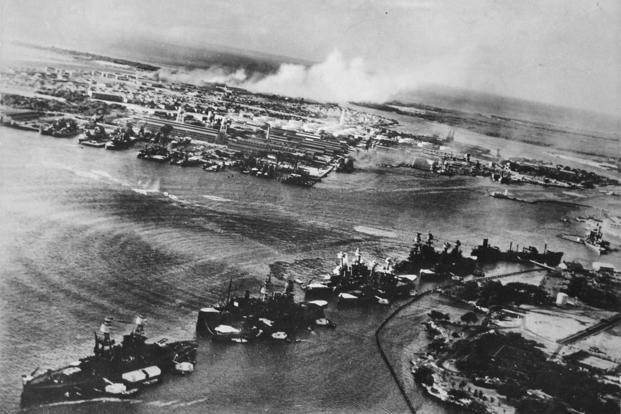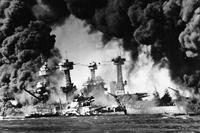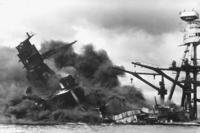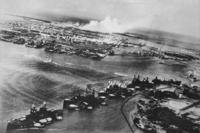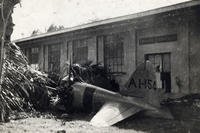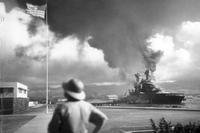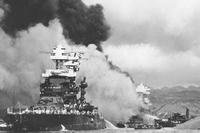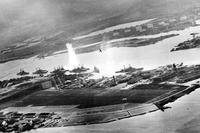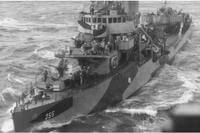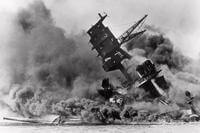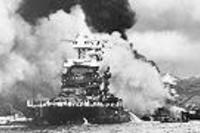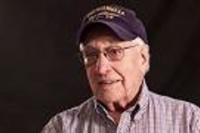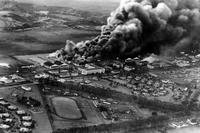No American military engagement has undergone more post-mortems than the Japanese attack on Pearl Harbor. Between 1941 and 1946, various departments of the U.S. government conducted nine official inquiries. A tenth inquiry was held as recently as 1995, when the Department of Defense re-examined the culpability placed on Rear Admiral Husband E. Kimmel and Major General Walter C. Short for a lack of preparedness prior to the Japanese attack on Pearl Harbor. The investigation, issued as the Dorn Report, absolved Kimmel and Short of responsibility for the devastation caused by the attack and recommended posthumously restoring Kimmel and Short to the ranks they held prior to the attack.
The attack has spawned a heated debate over whether the Roosevelt administration had advance knowledge of the impending attack and allowed it to take place to create a pretext for U.S. entry into World War II. In September 1944, John T. Flynn, a co-founder of the America First Committee, published a 46-page booklet, The Truth About Pearl Harbor, in which he formally raised what historians have called the "advance-knowledge conspiracy theory." The debate still rages.
Historians have dismissed the theory as unsupported by historical fact, although there are plenty of vague references in government documents and personal correspondence pointing out the inevitability of a war with Japan and even welcoming such a prospect. Some historians have gone so far as to argue that Roosevelt's policy toward Japan was deliberately provocative and was intended to goad Japan into striking first at the United States.
There is also evidence, however, that by 1940, the Roosevelt administration had decided that war with Germany was inevitable and was already preparing for such an eventuality. In this case, a war with Japan was a distraction that would divert resources from the effort against Germany. Particularly intriguing, on this point, is the story surrounding the adoption of "Plan D."
Shortly after the 1940 presidential election, a campaign in which Franklin D. Roosevelt ran on the promise that "no American boys would be sent to fight in Europe," he received a briefing from Admiral Harold R. Stark, the Chief of Naval Operations, on the war situation in Europe. Stark told Roosevelt that without American aid Great Britain would inevitably be defeated by the Nazis, leading to German domination of Europe, Africa and the Middle East. About that time, Roosevelt also received a letter from Albert Einstein in which he warned that Nazi Germany was working on the development of an "atomic bomb" of enormous destructive power.
Stark subsequently laid out possible policy options to Roosevelt in a formal memo. The fourth option, titled "D," argued for a "Germany first" strategy regardless of any potential threat from Japan, and recommended that American assistance to Britain should also include the deployment of U.S. troops in North Africa and Europe. That policy recommendation, later dubbed "Plan D," was widely supported within the Roosevelt Administration, including by then-U.S. Army Chief of Staff, George C. Marshall. It was at that point, a year before the Japanese attack, that Roosevelt authorized joint talks between the British and American military chiefs of staff to implement "Plan D." The "Germany first" policy wasn't officially announced to the public until the "Arcadia Conference," a year later, between Roosevelt and Winston Churchill, held in Washington DC between December 22, 1941 and January 14, 1942.
U.S. Naval operations in the Atlantic over 1940 and 1941 were consistent with Roosevelt's focus on Germany. Following the start of WW II, Stark had ordered "Neutrality Patrols" in the Caribbean and in waters 200 miles off the coasts of both North and South America. Over the course of 1940, the Navy conducted "battleship sweeps" in the western Atlantic to deter German commerce raiders and U-boats from entering the neutrality zone. In 1941, the number of ships assigned to those sweeps doubled and their patrol zone was extended all the way to Iceland. In September 1941, U.S. Navy destroyers, in collaboration with the Royal Canadian Navy, began escorting Canadian and British merchantmen as far as Iceland. The America First Committee criticized the convoy escort activity as being deliberately provocative to Germany and accused Roosevelt of seeking a war with Berlin.
The history of the signal intelligence obtained by the U.S. in the period immediately prior to the attack has also encouraged the conspiracy theorists. American code breaking activities were very sophisticated and highly advanced. The U.S. had succeeded in breaking many, although not all, of the Japanese military and diplomatic codes. Nonetheless, the application of that intelligence was often haphazard. There was a widespread shortage of Japanese translators. Turnover among cryptographers and intelligence analysts was high. Both activities were considered dead-end jobs; ones that could stigmatize future career prospects.
Intelligence sharing was equally haphazard, with different government departments hoarding their signal intercepts. Ironically, the U.S. had broken the Japanese diplomatic code dubbed "Purple," which was used by Tokyo for important communications with its embassies. A 14-part message instructing the Japanese ambassador in Washington to advise the State Department that Tokyo was breaking off diplomatic relations with the U.S. had been decoded on December 6 and 7, and had been correctly interpreted by the War Department as indicating a Japanese attack at dawn somewhere in the Pacific. Unfortunately, the warning sent to U.S. military forces in the Pacific was, because of atmospheric conditions, dispatched by Western Union. The telegram arrived in Hawaii during the middle of the first wave of attacks.
The fact that some documents relating to the attack are still classified has also provided fodder to the conspiracy theorists. There is signal intelligence obtained by the British "Ultra" and the U.S. "Magic" programs relating to Pearl Harbor, for example, which is still secret. In addition, there are also reports of other documents, for example, a purported, explicit warning from military intelligence in the Dutch East Indies of an impending Japanese attack on Pearl Harbor, that are still classified. There is also the fact that many documents at Pearl Harbor were destroyed in the weeks following the attack for fear of an impending Japanese invasion.
One historical fact that is not open to dispute, however, is the mock raid that was staged on Pearl Harbor on February 7, 1932, as part of a military exercise designed to test Pearl Harbor's vulnerability to a surprise attack. In the period between the Washington Naval Conference in 1921, and 1940, the U.S. did not have a two-ocean navy. The main Pacific anchorages were in San Diego and San Francisco where the fleet could be deployed quickly in the defense of the Panama Canal or of the Hawaiian Islands. Its proximity to the canal also allowed for its rapid transfer to the Atlantic should it be needed there.
"Planners" at the War Department had been considering the possibility of war with Japan since at least 1906. The eventual strategy, dubbed War Plan Orange, anticipated that in the event of a war with Japan, the Philippines and American bases in the western Pacific would be either blockaded or overrun. In the interim, the U.S. Pacific Fleet would concentrate its strength along the West Coast until the ships had received their full complement of crew. During the 1930s, ships operated with only half of their allotted crew as an economy measure. Once the fleet had been readied, it would sail west to relieve the Philippines. With the Philippines secured, the fleet would proceed to blockade Japan and seek a decisive naval showdown with the Japanese fleet.
This strategy was consistent with the writings of American naval strategist Alfred Thayer Mahan who argued that future wars would be settled by decisive naval engagements. This view was widely shared among the world's naval powers, including Japan. Given the critical role of Hawaii in a Pacific campaign, the idea of beefing up U.S. Naval forces at Pearl Harbor was not new. It had been discussed since at least the end of World War I.
Since 1923, the U.S. Navy had conducted large-scale naval exercises, termed "Fleet Problems," during which U.S. Naval forces would engage in mock battles with a purported European or Asian attacker. Fleet Problem Number 13 was a mock attack by a "militaristic, Asian, island nation against the military base at Pearl Harbor." The exercise was designed to test Pearl's defenses and assess its vulnerability to an attack.
The attacking force was under the command of Rear Admiral Harry Yarnell. The admiral was a qualified naval aviator, one of the few admirals to have earned his aviator wings at a time when battleship command was still the path to promotions. In 1927, he took command of the aircraft carrier Saratoga and was instrumental in developing carrier tactics. At the time, carriers were classified as "fleet scouting elements." They were not valued as capital ships and were considered expendable.
Yarnell maintained that Japan "had always started operations by attacking before a declaration of war." Accordingly, he designed an attack plan that utilized carrier aviation to launch a surprise attack on Pearl Harbor. Pearl's defenders had anticipated that Yarnell would attack with his battleships. Instead, he left his battleships behind and advanced with the carriers Saratoga and Lexington to a point north-northeast of Hawaii. At dawn, on Sunday February 7, 1932, Yarnell launched his attack with a force of 152 planes from the two carriers. His attack force first attacked the airfields and then proceeded to attack the ships along battleship row.
Yarnell achieved total surprise. The airfields were put out of commission, with not a single plane getting airborne during the attack. The attacking force scored multiple hits, they dropped sacks of white flour to simulate bombs, on the battleships. The umpires declared that Yarnell's attack had been a complete success and declared him the winner. The Army and Navy brass, however, would have none of it. They complained that Yarnell had cheated. He had attacked at dawn on a Sunday morning, a time considered "inappropriate" for an attack. His attack vector from the north-northeast had mimicked planes arriving from the mainland. Most importantly, the Navy argued, low level precision bombing of battleships at anchor was unrealistic since "everyone knew that Asians lacked sufficient hand-eye coordination to engage in that kind of precision bombing."
Pressured by the War Department, the umpires reversed their decision and declared that the defenders had won the exercise. The Navy and its "battleship admirals" ignored Yarnell's contention that Pearl Harbor was vulnerable to an attack by naval air power. The exercise was widely reported in the press and was observed by Japanese naval officers at the Japanese consulate on Oahu. Some 10 years later, the Japanese Navy would launch an almost carbon copy attack on Pearl Harbor, utilizing six carriers and double the air power used by Yarnell.
The only significant innovation employed by the Japanese Navy was the use of air-launched torpedoes against the ships in Pearl lagoon. A year earlier, the Royal Navy had used slow Swordfish torpedo planes to attack the Italian fleet at its base in Taranto. The success of that attack was not lost on Tokyo. The U.S. Navy had dismissed its relevance to Pearl because Taranto's harbor was around 75-feet deep, almost double the depth of Pearl Harbor, and it did not believe that air launched torpedoes would work in shallow waters. The Japanese Navy solved that problem by modifying their torpedoes to give them a flatter glide path.
The definitive story of the attack on Pearl Harbor has not yet been written. Pearl still has secrets to disclose. What is not a secret, however, is the fact that the Japanese attack plan against Pearl Harbor had been designed a decade earlier by an American admiral.
Joseph V. Micallef is a military historian, bestselling author, keynote speaker, syndicated columnist and commentator on international politics and the future.
